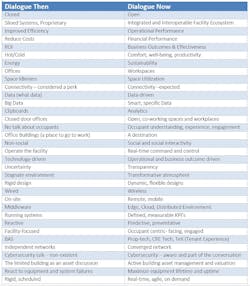I am pleased with your toleration of my bending of the English language to make a few edgy points with our chapter on Edge-You-Cation. That discussion plus this next chapter —Edge-ifcation — fits well with the book about our digital transformation we are all drafting together on the pages of the connected contractor.
Folks have joined in with their own words in addition to "Edge-You-Cation" and "Edge-ification," noting these words are nothing short of "punderful.” Identifying with the word twist, one of my favorites was "Edge-You-Caution." Yes, that is a good one and well worth pondering. Here is a phrase I enjoyed: "So I have been EDGE'em-ecating myself in my own way." People like to have fun with words, just like me!
This article just posted on LinkedIn, EDGE-YOU-CATION: The Never Ending Story (Part 2), shows we have created a bit of a cult.
This next chapter of the virtual book of our digital transformation deals with Edge-ifcation: moving the murky muddled middle to the edge to add simplicity, clarity, and redefined purpose, all while changing our perspectives to see the advantages of a world looked at from the edge instead of from the middle.
It’s the age-old question: centralize or de-centralize? It seems the new edge generation of technology is answering the question. There is no doubt that the traditional middle of our people pleasing processes has become murky and muddled, even to those that have created them. We are drowning in data. We need to deal with it at the edge, at the place where the data gets used, and then simply throw the data away.
This game-changing article from our contributing editor Marc Petock talks about one of the transitions of the evolving change in "Middleware." Middleware is the software that acts as a bridge between an operating system or database and applications, especially on a network. The Middleware is my "murky muddled middle" and with Edge-ifcation is moving to Edge, Cloud, and Distributed Environments (DCE). DCE uses the client/server model. Using DCE, application users can use applications and data at remote servers. Application programmers need not be aware of where their programs will run or where the data will be located. From Marc’s article, The New Dialogue in Smart Buildings:
Today, most have embraced the fact that technology is the game changer and is the cornerstone of operating buildings as an economic model. As the technology surrounding engineering design and energy management systems have evolved, so has the dialogue around smart buildings. Driven by digital transformation and a change in value propositions; changes in the role of facilities are shifting to create healthy, safe and productive environments.
A few years ago, the dialogue focused on energy, efficiency and lower operating costs.
So, what about now? What is the dialogue and conversations that are making their presence felt within our buildings and workplaces? How has it changed?
Is now the time to really focus on the Edge? ARC Advisory Group, the leading technology research and advisory firm for industry and infrastructure, gives an overview of the promise that edge computing holds. Key quote:
Edge computing and analytics are increasingly being located close to the machines and data sources. As the digitization of industrial systems proceeds, so does analysis, decision-making, and control being physically distributed among edge devices, edge servers, the network, the cloud, and connected systems, as appropriate
Contributing editor Brad White, President of SES Consulting, shares his thoughts in this article, Elevating Smart Building Design to Create Attractive Spaces:
So what kind of smart building solutions might be attractive occupants? It may be snazzy that the heat or lights come on in my office when I scan my badge at the entrance, but that is probably not enough by itself to convince me to make an hour long commute into the office if I don’t have to. Having an app that tells me at a glance that my teammates are also going to be in the office and everyone is free for lunch, that very well could be enough to get me to make the trip. But once I’m at the office, I might decide to stay longer if my heat and lights are where I want them without having to think about it too much. Along these lines, it will be crucial that the user experience of the occupants is paramount when it comes to designing these solutions. While there may be lots of complicated stuff going on in the background, 99% of that should be invisible to the users (yes, that was a subtle plug for my favorite podcast). If your technology can do that, then it will be successful. I believe this will be driven by well designed, minimalist apps and systems that incorporate features like voice activation with natural language processing. When it comes to comfort, for example, users don’t want to have to think too much about why they’re uncomfortable. Is space temp too low? Air flow too high? Are the windows drafty? If occupants have to think too much about why they’re uncomfortable, then you already have a problem on your hands. Systems should be able to deduce occupants’ issues largely and respond appropriately, with the complexity being handled behind the scenes, invisible to the occupant. “Alexa, make me happy.”
As technology for supporting remote working becomes more advanced, there may be a day when the “virtual” office can offer the same employee experience as a physical one. I think that day is still a long way off. There remains considerable value in the physical office space, and the right space really can make employees happier and more productive. But achieving this will require paying close attention to what attracts your employees to the office and designing with the employee experience in mind. Otherwise, it’s going to be increasingly hard to convince people to get up off their couch, change out of our sweatpants and head into the office.
This seems like a good point to invite everyone who has read this far to join the discussion on the future of smart building solutions at AHR Expo this January in Atlanta. Our session is titled, “Next Generation HVAC Controls: Open Hardware – Open Software.”
When we start the dialog with people as the controlled variable on the edge we find conflicting thoughts from even our own creators of our new space.
The sense of agency (SA), or sense of control, is the subjective awareness of initiating, executing, and controlling one's own volitional actions in the world. In social science, agency is the capacity of individuals to act independently and to make their own free choices.
Light switches and manual thermostats give us a sense of agency and control for our office space. A simple operable window is a pleasure. Options are simply open or closed. No app required.
It interesting how quickly our discussions about edge-ifcation of our physical devices using new edge technology has turned to the social science of our new controlled variable, the housed people of our buildings.
Here is some insight from Amazon’s own developer page on how their voice controls are now a cost-effective interface to almost everything that closes the loop on complex tasks while providing a simple sense of agency.
Connect Your Devices to Alexa Reach and Delight More Customers
In this Podcast, Designing Digital Wellbeing with Scott Jenson, you can gain some insight into Google's thoughts about designing digital wellbeing. From the intro:
As a User Interface designer and strategic planner with over 20 years experience of working with some of the biggest companies in the world, Scott focuses on bringing to life Google’s digital wellbeing vision. This is a fascinating conversation in which you’ll get insight on the reasons why people feel obligated to answer their phones, why engagement metrics are only part of the story when designing for digital wellbeing, and the various ways Google is working at the operating system level to create digital wellbeing for everyone.
As you can see from the above discussions, Designing Digital Wellbeing Edge-ifcation to simplify the middle is a complex task but when done well it can create that necessary connectivity, while providing human beings that all-to-human need, a sense of agency.
About the Author
Ken Sinclair
Editor/Owner/Founder
Ken Sinclair has been called an oracle of the digital age. He sees himself more as a storyteller and hopes the stories he tells will be a catalyst for the IoT future we are all (eventually) going to live. The more than 50 chapters in that ongoing story of digital transformation below are peppered with HTML links to articles containing an amazing and diverse amount of information.
Ken believes that systems will be smarter, self-learning, edgy, innovative, and sophisticated, and to create, manage and re-invent those systems the industry needs to grow our most important resource, our younger people, by reaching out to them with messages about how vibrant, vital and rewarding working in this industry can be.

